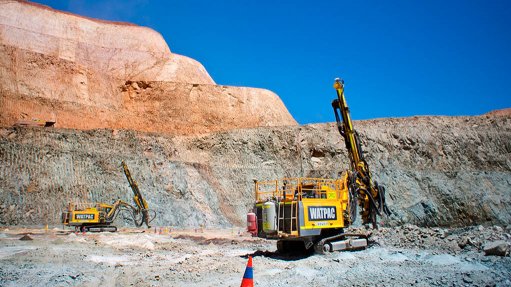
Name: Mt Magnet mine.
Location: Mt Magnet is located 500 km north-east of Perth, in Western Australia, along the Great Northern Highway.
Controlling Company: Ramelius Resources.
Brief History: Ramelius acquired Mt Magnet Gold in 2010 from Harmony Gold and restarted operations in late 2011.
Historically, Mt Magnet produced more than 5.6-million ounces of gold since its discovery in 1891 and has significant potential to host new discoveries. The Hill 50 underground mine produced more than 2.1-million ounces of gold and was the largest gold producer in the field until the mine was closed in 2007. It had been mined to 1 500 m below surface, demonstrating the depth continuity of high-grade mineralised shoots within the Mt Magnet project area.
Ramelius’ operations have comprised large openpit cutbacks on the Saturn and Mars pits, collectively referred to as the Galaxy mining area. In early 2015, these pits were approaching planned depths and the Perseverance openpit cutback was started. Perseverance (Percy) is located at the top of the Hill 50 underground mine and will provide the main ore source in the 2016 financial year.
Brief Description: The Mt Magnet project consists of numerous openpit and underground mines, and exploration targets on established mining and prospecting leases. The total project area covers 225 km².
Products: Gold.
Geology/Mineralisation: The Mt Magnet mine is located within the north-south-striking Meekatharra-Mt Magnet greenstone belt of the Western Australian Murchison province. The greenstone belt lithologies comprise a succession of steeply dipping and intensely deformed, interlayered mafic and ultramafic extrusive and intrusive rocks, felsic volcanics and banded iron formations (BIF). Granitic rocks intrude the greenstone belt stratigraphy.
BIF are the dominant host rocks for gold mineralisation in the project. Gold mineralisation is typically associated with the pyrite and pyrrhotite replacement of magnetite in the banded iron. Economic high-grade ore shoots are developed along the intersection of the BIF and a swarm of north-east-trending faults, colloquially referred to as Boogardie Breaks.
Reserves: Total proven and probable reserves as at June 30, 2014, were 5.18-million tonnes grading 2 g/t of gold.
Mining Method: Openpit, contractor mining.
Major Infrastructure and Equipment: The Checkers gold mill is an existing 1.7-million-tonne-a-year conventional semi- autogenous grinding gold mill about 4 km from the Galaxy mining area. The mill has previously been operated at 2.4-million tonnes a year and could be reconfigured if required.
Prospects: The cutback at Percy started in January this year and will provide the major ore source for Mt Magnet for the 2016 financial year.
Mining was accelerated during the second half of the 2015 financial year to access the higher-grade, fresh ore, which starts about 50 m below surface level.
The September 2015 quarter will result in increased access to ore at Percy as exposure of the main Hill 50 and Perseverance BIF lodes begins.
Mining at the Saturn and Mars openpits will be completed in the September 2015 quarter, as the bottom 20 m of ore is retrieved using the smaller 50 t capacity mining fleet.
Contact Person: MD Mark Zeptner.
Contact Details:
Ramelius Resources,
tel +61 8 9202 1127,
email info@rameliusresources.com.au, and
website http://www.rameliusresources.com.au.